Introduction
For this PT, I wanted to try something a little different. After testing with Eureka last season, I realized that A – it was great and B – the level of commitment that was required to do that again was just a little too high for a non-professional player like myself. Basically, testing like an actual pro put so much pressure on the other aspects of my life (work, hobbies, relationships) that it would have ended up ruining the fun in the long term. Still, I did want to come prepare and perform to the best of my abilities.
Luckily, this year, France has a ton of Silver pros that I know and like, and we made plans to test together in a way that accommodates everyone while still being as professional as possible. We rounded up the squad with some very talented players that just happened to be qualified, and ended up with a good mix of talent and camaraderie know as Team Renaissance:
Thierry Ramboa (Silver Pro)
Arnaud Soumet (Silver Pro)
Julien Henry (Silver Pro)
Louis Deltour (Silver Pro)
Steve Hatto (Silver Pro)
Remi Fortier (PT Champ)
Kevin Chiche
Noham Maubert
Arnaud Hocquemiller
Alexandre Aurejac
Mikael Rabbie
Laurent Calligaro
We agreed to start testing online as soon as the spoiler list was released (actually, most of us did not even wait that long), and only come to Hawaii one week before the PT to perfect our preparation and spend time on the beach.
Our expectations for StandardWith a ton of new cards and mechanics, along with the departure of the format-defining 《Collected Company》 and 《Dromoka's Command》, it was actually very tough to define a gauntlet. Like everyone, we identified RW Vehicles and BR aggro as two very powerful decks (we even had more explosive versions that exploited the “combo” of 《Lupine Prototype》 + 《Key to the City》), and we all knew that BG Delirium was very much a deck.
 |  | 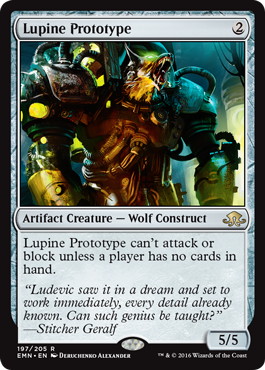 | 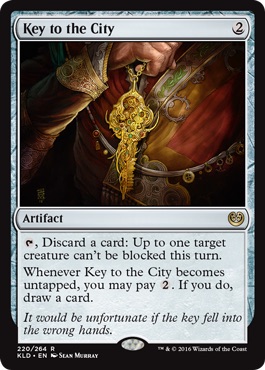 |
The one thing that we actually got wrong is, well, all the rest. Very early in testing, Louis Deltour built pretty much the exact same UW tempo deck that got Joey Manner in the top8. It ended up having a huge impact on our gauntlet, resulting into us dismissing Green-White Tokens, 《Aetherworks Marvel》 and 《Metalwork Colossus》 as strategies that just folded to 《Spell Queller》 super hard. Do not get me wrong: we built all those decks, and we knew they were functional, but we just thought that never beating UW would be enough to keep them out of the metagame.
For that reason, we thought that most of the field would stick to the “level one” decks that are Red Aggro and BG Delirium. And those were not good match-ups for Blue-White, especially Black-Green with those pesky 《Ishkanah, Grafwidow》. Which brings me to…
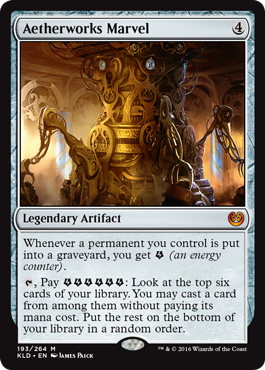 | 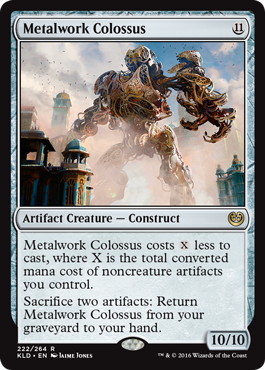 | 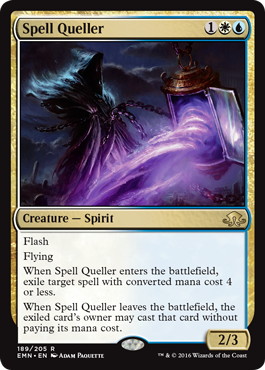 | 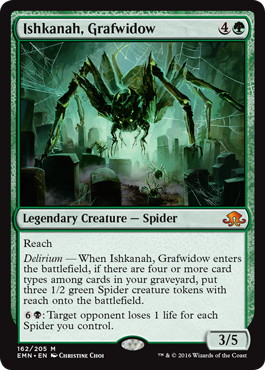 |
UR Tower (or UR Niblis of Frost?)
Early in the testing, Kevin Chiche came up with a reasonable version of a 《Dynavolt Tower》 deck that also had 4 《Thing in the Ice》. We did not love it, but it had decent results against the metagame from the Starcity Games. As our testing progressed and we gave more and more credits to those decks as “the only decks that could beat Blue-White”, I decided to rebuild his decks and remove the 《Thing in the Ice》 to blank any removal my opponents might play. The results were phenomenal against Vehicles and Black-Green, and very decent versus Black-Red even though 《Scrapheap Scrounger》 was a major nuisance.
Basically, killing their first threat on turn 1 or 2 was enough to let you play a 《Dynavolt Tower》 on turn 3 and untap with it at a healthy life total (10 or above). From that point, you could just kill all their creatures while drawing cards until you played a second tower and started targeting them. We were especially happy with how easy it was to deal with 《Smuggler's Copter》, because all of those decks are a bit clunky when they do not get to loot every turn.
 | 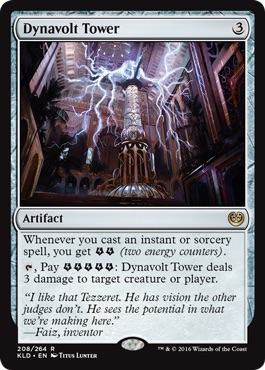 | 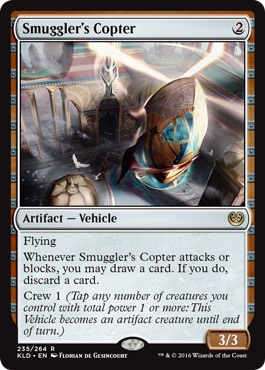 | 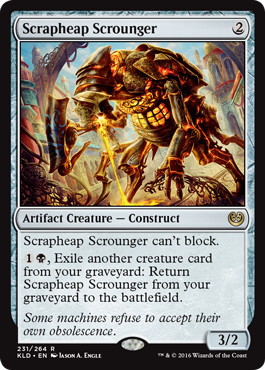 |
Of course, basing your game plan on a lightning bolt effect has its weaknesses, the most obvious one being that you can never kill something really big (like an 8/8 《Verdurous Gearhulk》 or a 10/10 《Metalwork Colossus》). A playset of 《Lightning Axe》 maindeck helped a little, but I was far from thrilled…until we found 《Niblis of Frost》. It was basically the perfect card for our sideboard: not only was it much safer to play on turn 4 after they board out most of their removals, it also lets you deal with whatever giant threat they have while needing almost no adaptation, since 《Niblis of Frost》 and 《Dynavolt Tower》require the exact same shell (cheap spells and card draw).
The funniest part is that the card also solves the combo match-ups: yes, the initial goal was to stop 《Verdurous Gearhulk》 in aggressive decks. But it just so happens that 《Niblis of Frost》 can handle three Metalwork Colossi by himself (as evidenced in my round 13 feature versus Oliver Polak-Rottman), can keep a healthy number of 《Prized Amalgam》 in check forever, and will even come in handy to stop an 《Emrakul, the Promised End》 (a card that you literally cannot kill game 1, even if you draw your entire deck).
After a good amount of tweaking, here is what I registered at the PT:
|
3《Aether Hub》 1《Highland Lake》 4《Wandering Fumarole》 4《Spirebluff Canal》 6《Mountain》 6《Island》 -Lands (24)- 1《Torrential Gearhulk》 -Creatures (1)- |
4《Dynavolt Tower》 3《Tormenting Voice》 4《Take Inventory》 4《Anticipate》 2《Glimmer of Genius》 4《Harnessed Lightning》 4《Fiery Temper》 4《Lightning Axe》 3《Void Shatter》 3《Galvanic Bombardment》 -Spells (35)- |
1《Glimmer of Genius》 1《Galvanic Bombardment》 1《Torrential Gearhulk》 4《Niblis of Frost》 4《Thing in the Ice》 2《Ceremonious Rejection》 2《Negate》 -Sideboard (15)- |

So, how good is the deck after all? The answer is definitely not “great”, even though I had a good run with it and love the way it plays out. Game one, your match-ups are very heavily polarized: you will rarely lose to Black-Green or Red-White (despite what happened in the top8, I would still consider Blue-Red to be a heavy favourite there), but you will never beat 《Aetherworks Marvel》, Colossus, or Grixis Emerge, because those strategies can just ignore a 《Dynavolt Tower》. The other match-ups are fifty-fiftish, and usually super skill-intensive. That is a fairly grim picture, I know, and I actually went 5 and 5 in maindeck games during the Swiss portion.
What really makes the deck tick, though, is how great the sideboard is. I might not have had the best 60 cards for the tournament, but my 75 were really strong; we tested a ton post-board, and it resulted in me going 13-3 in sideboarded games. This is in no small part due to the surprise factor and people not respecting 《Niblis of Frost》 when they should have, but even dismissing that, it is just super hard to sideboard correctly against you: you can (and you should) sideboard differently depending on who plays first, which cards you saw in game 2, and what your opponent thinks you will do.
 |  | 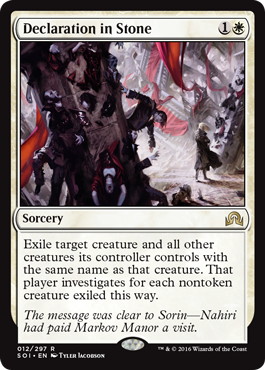 |
For example, whenever I lost game 2 against Vehicles (usually, that happens because they play first and they punish you with a 《Chandra, Torch of Defiance》 whenever you cast 《Thing in the Ice》 or 《Niblis of Frost》), I just brought the towers back in and could just laugh at all those 《Skywhaler's Shot》 and 《Declaration in Stone》. Against combo decks, you can even transform into a draw-go deck that counters everything and then slams a 《Torrential Gearhulk》 to close out the game in a very Wafo-Tapa-esque manner, just like any real French deck should.
The Tournament itself: LimitedI thought the draft portion was going to be a little bit challenging for me: since I bring much more to the table for my team when I test constructed, I had decided to skip quite a few drafts to focus on standard instead, and I just resorted to the recipes they gave me. To make it simple, we figured that this is a format where attacking is not as easy as usual, mostly because the servo tokens are better at defending, and also because early curve creatures get outclassed very fast. In Eldritch Moon, for example, my team (Eureka) loved “Unbeatable Wolf” 《Brazen Wolves》 and we picked it very highly.
The reason for that is that it was an aggressive 3-drop that would outclass almost every other 3-drop when attacking, and would easily trade with most 5-drops. In this limited format, a simple 《Peema Outrider》 will brickwall literally every non-evasive 3-drop, and you could very easily curve 2-drop, 3-drop, and never get to attack. As a consequence, boards tend to stall a bit until a player casts one creature that will break parity (either an evasive creature, a giant dude or a bomb rare). So, if you want to win in Kaladesh limited, you will need two things: creatures that break parity, and removal for when your opponent draws his way to break parity before you do.
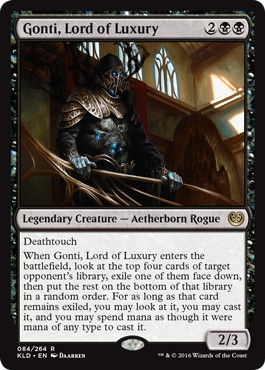 | 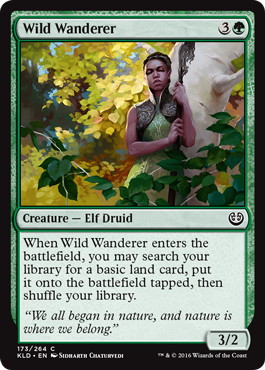 | 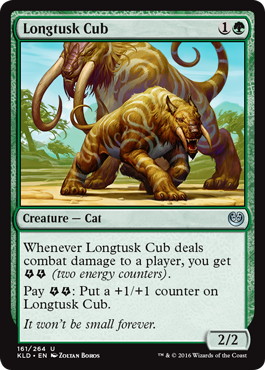 | 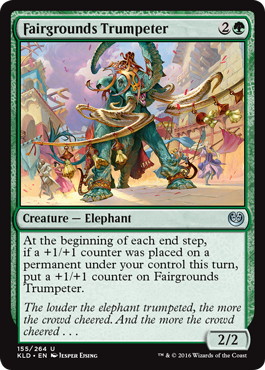 |
My first-draft, I was able to follow this plan perfectly, and drafted a super solid Black-Green deck withsix removal spells , 《Gonti, Lord of Luxury》, and a bunch of 6-drops to accelerate in with some 《Wild Wanderer》 so that I could attack on stalled boards. That is exactly what I did, except when I played 《Longtusk Cub》 into 《Fairgrounds Trumpeter》 against Frank Karsten and earned a turn 4 concession to start my tournament. Apart from that, green fatties and black removals easily got the job done and got me the perfect start.
The second draft was featured, and was off to a much shakier start when I was forced into blue-white (literally seeing no other colour in the first two packs). That colour combination does not really let me utilize my initial plan, since it has a ton of ways to break parity but is very bad at creating stalemates and lacks solid removal (I have found 《$Revoke Privilege》 and 《Malfunction》 to be extremely underwhelming cards).
 |  | 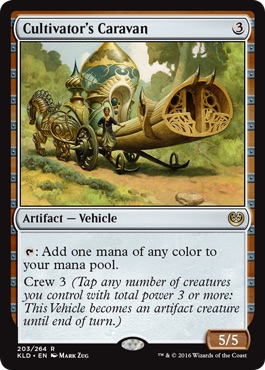 |  |
I was also passing to Shota, and fed him an insane deck with a third-pick third-pack 《Noxious Gearhulk》; my reasoning here was simply that he was 8-0 to my 7-1, and the more I fed him, the more unlikely it was that I would have to play against him. Despite not liking my deck, card quality was definitely there with 《Skywhaler's Shot》, 《Cultivator's Caravan》, 《Smuggler's Copter》 and a pair of 《Long-Finned Skywhale》, and I managed to 2-1 a very tough pod one, beating Reid Duke after he had to face the monster deck I had passed to Shota.
The Tournament itself: StandardThere were basically three kind of matches for me: good match-ups, Niblis match-ups, and bad match-ups.
The good match-ups were, obviously, Red-White vehicles (2 rounds) and Black-Green Delirium (three rounds). Against Red-White, you just mulligan any hand that does not interact in the first two turns on the draw (because you would not be safe to cast tower on turn 3 otherwise), and then just bolt everything, starting with their creatures. Against Black-Green, you just need to keep in mind that they will only win if they resolve either two Ishkanas (because the 6 spider tokens will race your towers) or an Emrakul (the trigger is easy to mitigate since you see it coming five turns before, but the 13/13 body is unbeatable), so you simply save your 《Void Shatter》 and develop your mana and hand until you are way too far ahead for them to come back. I won all those rounds fairly easily.
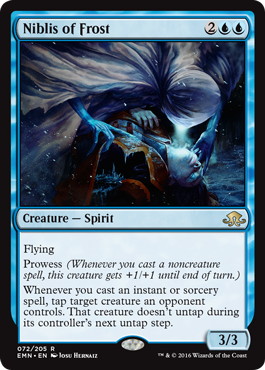 |  | 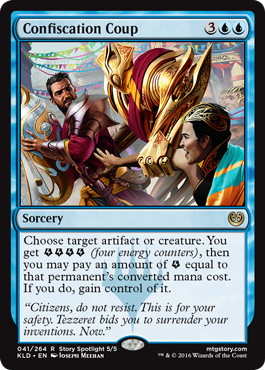 |
The Niblis match-ups are when you lose game 1, but keep smiling because you just know that 《Niblis of Frost》 will get them. Grixis Emerge and 《Metalwork Colossus》 are the most obvious examples; just play around whatever answers they could have to your Niblis (such as 《Confiscation Coup》), and you will get there, as you can see in my feature matches rounds 5 and 13, where I win the sideboarded games after getting utterly destroyed main deck.
The bad match-up is 《Aetherworks Marvel》; had I anticipated how popular it would be, I might even have played something else. You cannot really stop them, you are not really fast enough to tempo them, and even though 《Niblis of Frost》 helps, they will simply keep activating the Marvel until they catch you with an 《Ulamog, the Ceaseless Hunger》. I lost to this deck twice, and even though I beat it against Matt Nass in the final round, it had more to do with him drawing miserably and me chaining every single counterspell I had than anything else. Note that is does not necessarily mean that Blue-Red tower is unplayable: I honestly feel that the hype over Marvel was exaggerated, and the deck is bothtoo unstable and too easy to adapt f or to dominate in the future. But it is definitely a tough challenge for us, and I would probably wait a little bit before pulling the tower trigger again.
Judging under pressure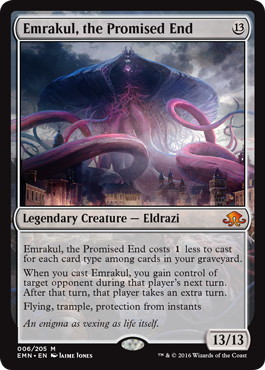 | 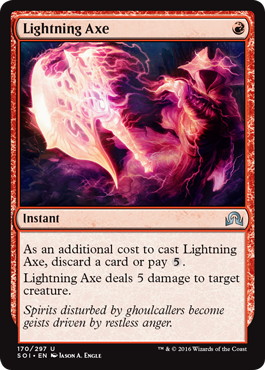 | 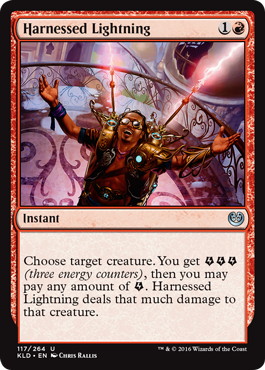 |
I also wanted to use this report to give a huge shoutout to the judges, and most specifically head judge Alfonso Bueno; in round 15, I got paired against Ondrej Strasky’s Black-Green delirium deck in a round where the winner would be almost guaranteed locked for top8. After I promptly won game 1, we had a very embarrassing sequence in game 2: he resolved an 《Emrakul, the Promised End》 when I had a Niblis on board alongside five lands, and my hand with 3 《Harnessed Lightning》, 1 《Lightning Axe》 and a 《Torrential Gearhulk》. I figured the best way to stay in the game was to play two 《Harnessed Lightning》 on my Niblis (saving the energy for later and triggering prowess twice), and then targeting it with 《Lightning Axe》 (discarding the last 《Harnessed Lightning》) so that it would survive as a 6/6, Ondrej could not kill it the next turn and Emrakul woud be tapped. That was a fine plan, and when my next lucky draws were 《Take Inventory》 followed by another 《Take Inventory》, I was in full control of the game and ready to secure top8.
At that point, though, one of my teammates who was watching the game pointed out that my Niblis had been afflicted by a Liliana’s +1, and should have been dead long ago. We called the judges, and we both agreed 100% about what happened; The problem is that two turns had passed, I had drawn something like 7 cards, attacked with my 《Niblis of Frost》… that was a very unconventional back-up to realize, and the initial ruling was that we would keep the game as it was.
That was an extremely uncomfortable situation: if we do not back-up, either I close out the game and totally scum Ondrej out of contention (which is just super unfair), or I concede and go to a game three despite the fact that I still had a real shot of winning even if my Niblis died. Thank god, since Ondrej was controlling the first of my two turns, it was possible to keep track of my draws; I pointed this out, Ondrej kept his cool and just calmly helped figure out how exactly we could recreate the game without altering it too much, and Alfonso carefully proceeded to do the back-up, deviating a little from the IPG (which we both made clear we were totally ok with) but ultimately making the game entirely fair to both players.
I lost that game, but I gained a lot of respect, not only for Ondrej who never lost his calm despite the pressure, but also for the judges who took it upon themselves to enact a much harder ruling than they had to, just to make things right for the players. I can only imagine how bad both Ondrej and I would have felt otherwise, so huge props to them.
Losing in the top8 and winning in the futureMy top8 bracket was fun: I was very happy to be paired against Ben Hull in stage 2 of the quarterfinals, since the match-up is very good. I knew that Shota’s deck would be a nightmare post-board , but my team came up with the plan of decking him maindeck and it turned out that was fairly easy to achieve if you played the whole game with that plan, so I figured I might win the first two games and hope for a lucky win in one of the post-board game (even though I honestly think he would have won 3-2). Obviously, things went south real fast when Ben gently sweeped me 3-0 on the back of his excellent draws and my clunky hands; he earned his semi-final appearance the hard way, and was a very competent, gentle opponent that will certainly do great in the future.
 |  | 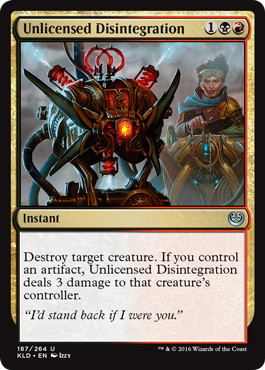 | 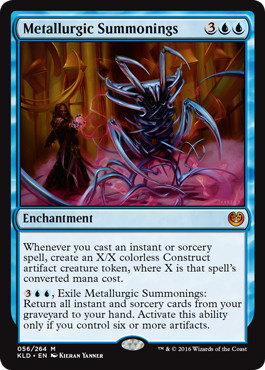 |
Going forward, I think the deck can be adapted to fit the new metagame; you clearly do not need so many 《Lightning Axe》 maindeck if no one is playing 《Verdurous Gearhulk》, and the 4th 《Void Shatter》 is definitely needed now that both Combo and Control have been unleashed on the battlefields. If 《Unlicensed Disintegration》 keeps losing popularity, I would also want a second 《Torrential Gearhulk》 maindeck as a way to pressure combo players while keeping my counterspells up. As for the sideboard, it will be utterly important to vary your threats and keep them guessing; right now, I would love to try 《Metallurgic Summonings》 as a way to dodge 《Confiscation Coup》 while providing an unbeatable threat for Control decks.
I tested it a little before, and I already know it will be a good fit for the deck. Looking in the same direction, it feels like 《Fevered Visions》 would be a nighmare to play against for both Shota and Romao’s decks from the finals, so that is definitely on my list. I know, none of those cards will fix the 《Aetherworks Marvel》 problem, but every other match-up seems manageable with the tools at our disposal.
Until next time,
Pierre Dagen
Share in Twitter
Share in Facebook
 Pierre Dagen
Pierre Dagen
One of Europe’s most well-recognized players, whom at Pro Tour: Theros squared off against his “Les Bleus” teammate Jeremy Dezani in a Mono-Blue Devotion mirror match in the finals, a game to go down in magic history. Other notable achievements include a second PT top8 in Honolulu 2016, 3 GP Top 8’s, and 3rd place at the World Magic Cup 2015 as captain of the French team.

Related Articles
- 2016/09/08
- Standard Post Kaladesh Rotation
- Oliver Polak-Rottmann



